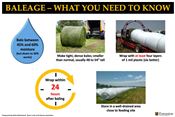Forage - Mission Possible?
LINDA GEIST
COLUMBIA, MISSOURI
Interested in an impossible task? Try making dry hay in Missouri in early spring. But baleage can turn spring forage harvest in Missouri into “Mission: Possible.”
Baleage is the ensilage of large bales of high-moisture forage, says Rob Kallenbach, University of Missouri Extension forage specialist.
Producers make large round or square bales of high-moisture forage and wrap the bales with plastic soon after harvest. Wrapping the bales excludes oxygen. This leads to fermentation, a.k.a. ensiling. This practice is often called bale silage, or baleage.
Compared to dry hay, baleage can be harvested much sooner after cutting. Dry hay is baled at about 16 percent moisture. That takes four to five dry days of curing time in early spring. Baleage, on the other hand, can be baled at 45 percent-60 percent moisture. That reduces the curing time to about one day.
In rainy weather, that makes a big difference, says MU Extension dairy specialist Stacey Hamilton.
Several companies make bale-wrapping machines. The two most popular types are platform wrappers and in-line wrappers, says Ryan Lock, MU Extension specialist in plant science and technology.
Platform wrappers cover individual bales. Most platform wrappers pick up, wrap and dump bales as an operation following baling, but some newer balers incorporate a wrapper that completes both operations in one pass. Most platform wrappers cost less than in-line wrappers.
Other advantages of platform wrappers: holes in the plastic of one bale only spoil that bale; bales can be fed at any rate needed; and bales can be marketed more easily. The main disadvantages are the cost of plastic and the time required to wrap each bale. Also, users need a special loader attachment (clamp) to pick up and move bales without damaging the plastic.
In-line wrappers place the bales end-to-end and wrap the outside of the bales. Operators manually cover the ends of the first and last bale or insert a few “junk bales” at both ends of each row to seal it.
The result looks like a long tube of bales.
An in-line wrapper uses less than half as much plastic as a platform wrapper and requires less labor per bale. However, bales are less marketable to distant customers, and once a producer opens a row, the bales need to be fed at a constant rate to avoid spoilage. Air temperature governs the spoilage rate; spoilage is slowest in cool weather, allowing for a slower feeding rate.
If you decide to make some baleage this year, here are a few tips:
• Ideal moisture for baleage is 45 percent to 60 percent. This allows for complete fermentation of the forage. However, moisture content down to 30 percent, sometimes called “tough hay,” still works.
• Make dense, tight, consistently sized bales. Usually, round bales should be only 48-54 inches tall. Remember, the bales will be heavier than dry hay because of the additional water content. Tie bales with net wrap, natural fiber twine or plastic twine. Avoid treated sisal twine.
• Wrap bales with a good-quality, 1-mil plastic resistant to sunlight with a minimum of four layers of plastic with a 50 percent overlap.
Six layers are better.
• Wrap bales within 24 hours of baling. Sooner is better.
• Store baleage at a well-drained site close to the intended feeding area. Patch holes promptly; if available, use UV-protected plastic tape, but duct tape works in a pinch.
• Consider how you will dispose of the plastic at feeding time.
Recycling is best when available.
For more information, go to ipm.missouri.edu/cropPest/2022/5/baleage-RK.
LINDA GEIST: University of Missouri
